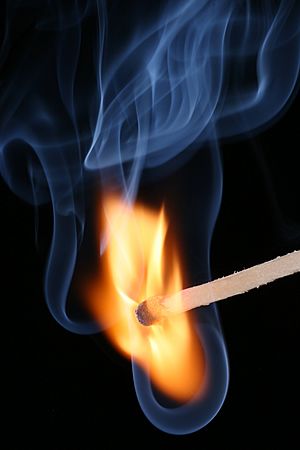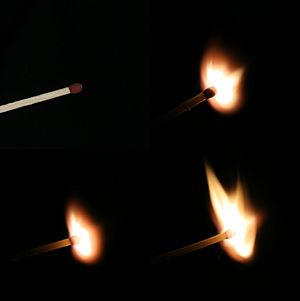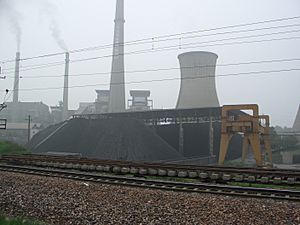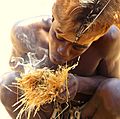Fire facts for kids
Fire is a fast chemical reaction that creates light and heat. It's a type of process called oxidation, where a substance combines with oxygen.
Contents
What is Fire?
Fires are usually combustion reactions. This means they happen when things like carbon, hydrogen, and oxygen mix and react quickly. There are many kinds of fires, and they can be very dangerous if not handled properly. For example, there are wood fires, gas fires, and even metal fires.
Putting Out Different Fires
Most wood fires can be put out with water. Water helps by absorbing the heat. But metal fires are much hotter. If you use water on a metal fire, the water will just turn into steam very quickly. For metal fires, sand can be used to cover them. This stops the fire from getting oxygen, which it needs to burn. A fire extinguisher can put out most common fires.
Fire Safety
Fire is extremely hot, so you should never touch it. If fire touches human skin, it can cause painful blisters that take time to heal. If a fire starts, try to cover your mouth with a wet cloth. This helps prevent you from breathing in too much smoke, which can make you faint. Always make sure there are no flammable materials close to a fire when people are nearby.
How We Use Fire
Fire can be very helpful when used carefully. For a long time, people have needed fire for its heat on cold days. It's also essential for cooking food. The light from fire is useful for seeing in dark places.
The Fire Triangle
Fire needs three things to burn: oxygen, fuel, and heat. This is often called the "fire triangle."
- Fuel: This is anything that can burn, like wood, coal, or oil.
- Oxygen: Fire needs oxygen from the air to keep burning.
- Heat: Once a fire starts, it creates its own heat, which helps it keep burning.
If you take away any one of these three things, the fire will stop.
Stopping a Fire
You can stop a fire in three main ways:
- Remove the fuel: If a fire runs out of things to burn, it will stop. Firefighters sometimes remove trees or buildings in a fire's path to stop it from spreading.
- Remove the oxygen: This is called "smothering" a fire. If you cover a fire with something that blocks oxygen, like sand or a special blanket, it will go out. Fires cannot burn without oxygen.
- Remove the heat: The most common way to do this is by using water. Water absorbs the heat, cooling the fire down until it stops burning.
However, some fires, like those involving certain metals, can be tricky. For example, magnesium fires can even burn in carbon dioxide, so they can't be smothered with a regular fire extinguisher.
Humans and Fire
Learning to control fire was a huge step for early humans. It changed their lives in many ways:
- Cooking: Fire allowed people to cook food. This made food safer to eat and easier to digest.
- Warmth: Fire provided heat, helping people stay warm in cold weather. This meant they could live in cooler places.
- Protection: Fire helped keep dangerous animals away at night.
- Tools: Over time, humans learned to use fire to make charcoal and manage the land.
Evidence suggests that humans might have used fire in a controlled way as far back as 1 million years ago. It became very common about 50,000 to 100,000 years ago.
Fire in Farming
During the Neolithic Revolution, when people started farming, they used fire to manage the land. They would do "controlled burns" or "cool fires." These were different from uncontrolled "hot fires" that destroy soil and plants. Cool fires were done in spring and autumn to clear small plants and dry leaves. This prevented big, dangerous fires later on. It also helped create different environments for plants and animals to thrive.
Another way farmers use fire is to clear land for planting. This is called "slash-and-burn" agriculture. Farmers cut down plants and then burn them. This releases nutrients back into the soil, which helps new crops grow. While useful for small farmers, this method can also cause problems. As populations grow and the climate warms, these fires can get out of control. This harms nature, damages buildings, and creates smoke that can cause health problems and even more warming of the atmosphere. Today, huge areas of land around the world burn each year.
Modern Uses of Fire
Fire is still used in many important ways today.
- Vehicles: Most cars and trucks use fire inside their engines to make them move. This happens in the internal combustion engine.
- Electricity: Many power plants use fire to heat water and create steam, which then generates electricity for homes and businesses.
Images for kids
-
Fire is affected by gravity. Left: Flame on Earth; Right: Flame on the ISS
-
Bushman starting a fire in Namibia
-
Painting of the Cathedral and the Academy building after the Great Fire of Turku, by Gustaf Wilhelm Finnberg, 1827
-
Fire-damaged restaurant waiting for demolition
See also
 In Spanish: Fuego para niños
In Spanish: Fuego para niños












